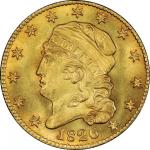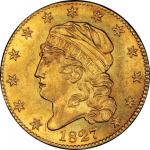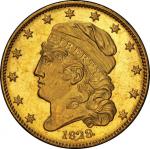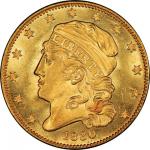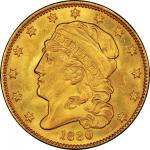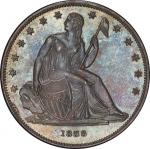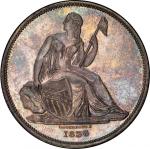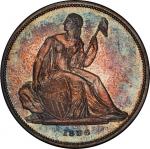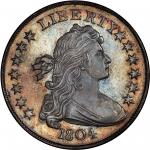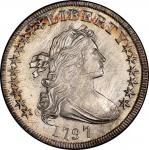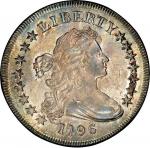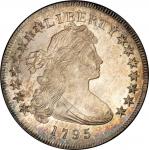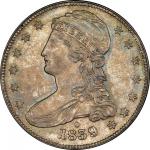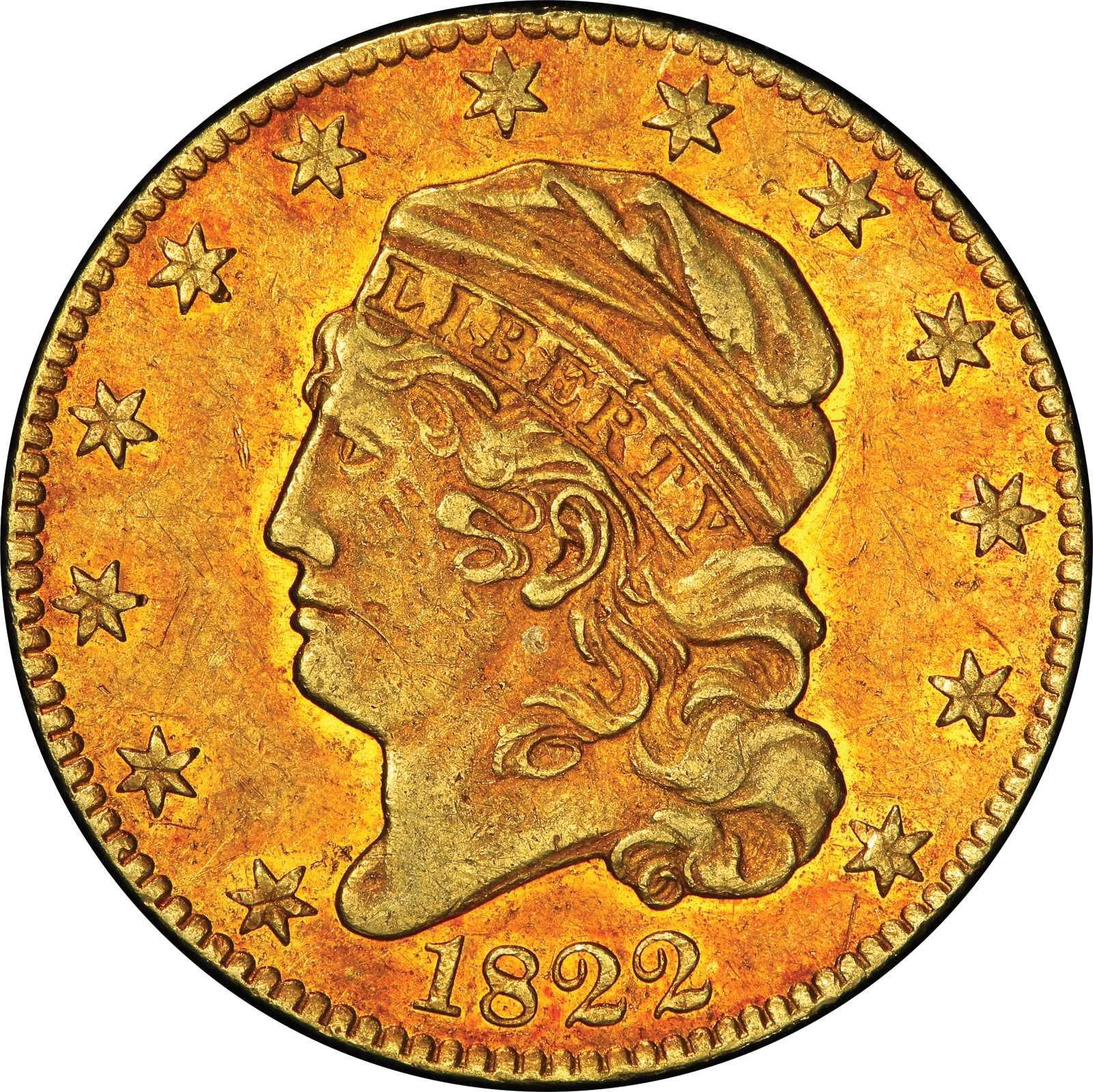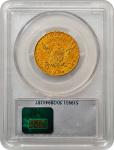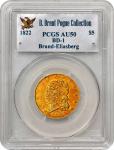1822年美国自由帽版5美元 PCGS AU 50。1822 Capped Head Left Half Eagle. Bass Dannreuther-1. Rarity-8. PCGS AU 50.I have the only one not in the hands of the government.” — Louis Eliasberg, on the 1822 half eagle, 1975 One of America’s most noteworthy historic collectibles in any form, the only 1822 half eagle in private hands is an unassuming physical presence. Its surfaces are toned to a deep, elegant shade of amber and maize, highlighted with subtle hints of pale green and ruddy violet. Coronas of luster shine outside all design elements, bright and reflective, framing Liberty’s portrait, the date, each star, along with the eagle and peripheral legends on the reverse. Its aesthetics are positive, but not in a showy way. This is not a gem, nor does it glitter like a jewel. This piece displays antiquity.
It shows wear and use. Its surfaces suggest its life before collectors and cabinets and fame. Within the shadows of contrast between a coin worth $5 and a coin worth millions, this coin hides a story whose earliest details will forever remain unknown.Though the devices show even and pleasing wear, it is evident that the strike is complete and finely detailed. The usually encountered areas of softness on this type, such as Liberty’s lowest curl and hair curl on the obverse, or the wings of the eagle or its talons on the reverse, are each well realized. The stars have their centers and the denticles are nicely formed. The scattering of minuscule lines and marks weaves a narrative of pockets and bags, of anonymity in a crowd of gold. The most notable individual mark is a nick in the upper left obverse field, between star 4 and Liberty’s nose. A light dig left of star 9, an abrasion left of star 12, and a thin scratch to the lower left of star 13 catch the eye, but so too do the marks that have seen more wear, such as the dull dents below Liberty’s eye and the short ancient scratch at the corner of her mouth. The marks, taken as a whole, do not distract, rather, they form a tapestry, weaving a texture that is both chaotic and even, giving this coin a sense of history and appeal that no Mint State coin will ever know. The date is bold, punched neatly and evenly, close together and on a perfect plane.
The distinctive 2s come from the same punch, with a thick base that curves to a barely perceptible peak in the middle. This reverse was used to coin the half eagles of 1821 before the 1822, as well as those of 1823 and 1824 after it. The reverse die state is more similar to the 1823 half eagle in this collection than the 1821, showing the delicate and poorly rendered berry beneath the highest pair of olive leaves in a slender, claw-shaped formation, the shape it assumed after lapping, not its original unlapped outline as seen on the 1821 half eagles. No die cracks, clashes, or other natural flaws are seen. Nothing in the manufacturing process is known to have condemned the 1822 half eagle to extraordinary rarity. No cataclysm writ in steel shortened what would have otherwise been an issue of typical rarity. Rather, the production life of this die marriage ended in some unassuming fashion that went unrecorded by history, just as its few legendary survivors avoided the melting pot.There is no good reason for the 1822 half eagle to be as rare as it is. Its reported mintage of 17,796 is typical of the half eagles struck in this decade. Delivery data recorded by the Assay Commission shows that the Treasurer received groups of half eagles that had been struck in 1822 on March 25, May 24 and 27, August 6, October 26, November 2, and January 24 of the following year. On each of these dates, three half eagles were set aside, and on March 10, 1823, all 21 were melted down and assayed to prove their weight and fineness. No United States Mint document indicates the date of those coins, however. Many of them were likely dated 1820, and some could also have been dated 1821. John Dannreuther has suggested that potentially none of the half eagles delivered in 1822 were dated that year, and his study of half eagle die states leaves open the possibility that 1822 half eagles were actually struck after those dated 1823 and 1824.
Despite an abundance of information, including mintage figures and delivery dates, no scholar or library anywhere holds a certain answer to the question of how many 1822-dated half eagles were struck.Survivorship percentages of early half eagles are tiny, typically well under 1% of the recognized mintage. The three surviving 1822 half eagles may, instead of representing an historical fluke that produced an extreme rarity, constitute the expected number of specimens remaining from a mintage of a few hundred pieces, given typical survivorship probabilities. Half eagles have been among the most popular series for generations of American numismatists. No other gold denomination was so unfailingly struck, year in and year out, from the beginning of American precious metal coinage in 1795 until 1916. Besides cents, which have been struck with every date from 1793 forward except 1815, no other denomination can compare to the half eagle. Collectors can find every date before World War I except 1801, 1816, and 1817. Including modern commemorative issues, they were struck at every single American minting facility, even West Point. In the 19th century, this continuity made completeness the goal of every collector with means. The attention on the half eagle put the denomination’s rarities in the spotlight. The 1798 Small Eagle and the 1795 Large Eagle were perhaps more famous in 1880 than they are today; an example of the former was for a short time the most valuable American coin in the world. The 1815 half eagle was the most celebrated rarity among American gold coins, outshining even the 1822, whose real elusiveness evaded notice for decades.The turning point in the story of the 1822 may have been the 1890 Parmelee sale. Lorin Parmelee collected the greatest cabinet of United States and colonial coins ever assembled in 19th century America.
Parmelee not only bought individual coins wherever he could find them, but he bought entire collections to get upgrades and issues he lacked. The collections he bought en bloc included some of the greatest numismatic cabinets of his era, like those of George A. Seavey, J. Carson Brevoort, and Charles I. Bushnell. Seavey’s collection of gold coins was considered complete as early as 1864. When the time came for Parmelee to auction his holdings, he was undoubtedly horrified to find that his 1822 was a counterfeit. In order to maintain the integrity of the cabinet, Harlan Page Smith, a principal of the New York Coin and Stamp Company, inserted his own coin into the collection, though he had no intent to sell it. It was cataloged with a casualness that stood out amidst the spare prose of the rest of the Parmelee lots, called “awfully rare from way back” and correctly characterized as “the first and only one ever offered at public sale.” Smith bought the coin back for $900, and it remained his until his death in 1902. By the time his collection was sold by the Chapman brothers in 1906, numismatists had finally grown aware of the date’s extraordinary rarity. Specialized numismatic auctions had, at that point, been commonplace for a half century, yet not one of them had ever included a genuine 1822 half eagle.Smith was fond of telling the story of his coin’s discovery, plucked from a bullion dealer’s stock for $6.50. When it sold in the auction gallery of Davis and Harvey, Auctioneers, at 1112 Walnut Street in Philadelphia on May 8, 1906, it realized $2,165, a record. “1804 dollars must now take a back seat,” reported The Numismatist soon thereafter. “An 1822 half eagle at the Harlan P. Smith sale in Philadelphia brought $2,165.” The winning bidder, William Forrester Dunham of Chicago, already had an 1804 dollar, but his 1822 half eagle was his greatest prize.When Harlan Page Smith’s 1822 half eagle found a new home, the only other example most collectors knew existed was the one that had long been in the Mint Cabinet. It had been there for decades, probably found by Adam Eckfeldt, the Chief Coiner who assembled a collection for the Mint unofficially before 1838 and with government funding and approval thereafter.
Perhaps Eckfeldt knew when he found it just how rare it was, or perhaps he only knew that it was a date the Mint’s collection lacked. By the time it arrived in his hands, with fingers and palms that were undoubtedly calloused and scarred by years working steel and powering screws, the half eagle also had seen its share of work. The Mint Cabinet coin is worn and nicked, set aside only after years in bags and boxes, counted and tossed with no more consideration than any other coin of its weight and fineness.Unknown to Smith or Dunham, another 1822 half eagle had turned up in 1899. It appeared out of nowhere in the hands of a little known dealer named Moritz David, an émigré from Germany. An emergency passport application submitted by David from Europe in 1917 tells his story. Born in Lautenberg, Germany in 1860, he moved to New York in April 1893. He was naturalized as a United States citizen in 1905. From 1914 to 1917, he lived in Europe, listing England, France, Germany, Austria, and Belgium among residences he kept during that time. When he applied for his emergency passport in February 1917, he was living in Barcelona. When he left from Antwerp in 1893, he was a “clerk.” When he applied for citizenship, his business was “merchant.” By 1917, after a few successful decades, Mr. David’s passport application listed his occupation as “art dealer.”Passenger lists of the era show that David traveled to Europe often, even before living there during World War I. From 1903 to 1906, he visited annually. His trips likely served the same purpose as his ads in The Numismatist, which advertised in 1897 that “M. David, 18 East 112th Street, New York, wants European coins and medals in gold and silver and will exchange others for the same.” In 1898, he offered assistance with “whole collections, bought or taken of and sold at auction, either in this country or in Europe.” United States coins were clearly not his primary business.
And yet, on August 14, 1899, Moritz David wrote out an invoice to the most acquisitive collector of United States coins there ever was, Virgil Brand, to sell him four rare early United States half eagles. The 1815, lower grade than the one Brand would acquire from the Guttag Brothers in 1925, was $200. It was Brand’s first example of the famous 1815 half eagle. Two more scarce dates, 1824 and 1826, were $60 each. David received the vast sum of $800 for an 1822 half eagle, a price that despite being enormous was cheap enough to suggest Mr. David didn’t know just how rare the 1822 was. He may have bought the half eagles in Europe, or he may have found them in his new adoptive homeland. They may have come as a group, or he may have located each individually. Nothing about David’s sources is known, though a European origin for the coins would fit with what is known about his business model.Virgil Brand purchased 4,471 numismatic specimens in 1899, at a sum cost of $7,464.77. The 1822 half eagle he purchased from Moritz David represented more than 10% of that expenditure, yet Brand would have undoubtedly paid more. It was the finest 1822 half eagle extant, and it remains so today. Brand’s 1822 half eagle was salted away with hundreds of thousands of other coins, unseen until after his death in 1926.In the meantime, word spread that Virgil Brand owned an 1822 half eagle. The description of the example sold from Harlan Page Smith’s collection in May 1906 included word that there was a specimen in the Brand Collection. “We know of but 3 specimens,” the Chapman brothers wrote, “U.S. Mint, Virgil M. Brand, and the present example was in the Parmelee sale [of] 1890, where it was loaned by H.P. Smith to take the place of Parmelee’s specimen which had proven to be counterfeit.”Following the H.P. Smith auction, no 1822 half eagle would change hands either publicly or privately for decades. Brand’s coin devolved to his estate after his death, a rope in the messy tug of war between brothers Armin and Horace. Coins went back and forth as the brothers horse-traded individual rarities and entire specialized collections. A court settled the division in 1937, and Virgil’s 1822 half eagle ended up in the hands of his brother Armin. In the meantime, the other private owner of an 1822 half eagle, William Forrester Dunham, passed away at the age of 79. Like the Brands, Dunham was a Chicagoan who built a superb cabinet.
Despite his wide-ranging interests, spanning from major Federal rarities to encased postage stamps and obscure early Canadian tokens, the Dunham Collection was nowhere near as massive as Brand’s. The whole assemblage was purchased outright by B. Max Mehl, who prepared a sumptuous catalog to announce his acquisition and, ostensibly, offer the collection at auction. The auction itself was, put charitably, non-traditional, with certain items being sold before the auction was ever held, and others retained by Mehl despite the publication of brow-raising prices realized. Other lots of more commonplace coins were sold to several different bidders, as Mehl selected items from his own stock that met the parameters of his vague descriptions. Only one coin was featured on the catalog cover. An impressive spread on Dunham’s 1804 dollar could be found inside the catalog, but the 1822 half eagle was clearly the star. B. Max Mehl’s profound excitement over the Dunham 1822 half eagle was tinted with youthful nostalgia. Mehl’s numismatic career was just underway when William F. Dunham outbid John H. Clapp for the 1822 half eagle in the 1906 Harlan Page Smith sale. Farran Zerbe described meeting Mehl for the first time the next month, June 1906, while Mehl “shared the novice bench with me” at Lyman Low’s sale of June 1906. “Mr. Mehl is perhaps the juvenile of the active dealers,” but Zerbe saw him fall “right into the ranks with the old timers” at the sale, where the record-setting 1822 half eagle was central to the conversation. Little could Mehl have expected then that 35 years later, he would be the old timer, and the Smith-Dunham 1822 half eagle would be on the cover of an auction catalog bearing his name. Mehl first met Dunham in 1910. Mehl was in Chicago with his wife when, “on our belated honeymoon, a refined looking gentleman called on us at our hotel.” They became friends, and the still-inexperienced Mehl looked up to Dunham as a mentor. After the sale’s completion, in the July 1941 issue of The Numismatist, Mehl could not retain his enthusiasm. “My life-long ambition and dream to catalog and successfully sell the Celebrated Dunham Collection came true!” The 1822 half eagle was announced to have brought $11,575, though the actual price was somewhat less.
Either way, the sales price was a new record sum for an American coin. The Dexter-Dunham 1804 dollar’s high bid was published as $4,250. Rather than selling to an auction bidder, Mehl had sold both in advance of the catalog even being printed. The 1804 dollar sold to Harold Bareford. The 1822 half eagle sold to Cincinnati collector Charles Williams. Williams owned it for only a few years before he sold his entire collection to Abe Kosoff’s Numismatic Gallery, a partnership with Abner Kreisberg. Mehl acted as middleman when the coin was sold to Texas businessman Amon Carter Sr. Like Williams, Carter owned the coin for only a few years, passing away in 1955 and leaving his coins to his son. In the late 1950s, Amon Carter, Jr. sold the 1822 half eagle to Stack’s for a customer named Josiah K. Lilly, the pharmaceutical magnate, who died in 1966. In 1967, Lilly’s coin collection, one of many collections he assembled, was appraised at over $5.5 million. In lieu of estate taxes, the whole collection was donated to the National Numismatic Collection at the Smithsonian Institution, a trade-off that required an Act of Congress. An Act for the Relief of the Estate of Josiah K. Lilly was enacted on June 4, 1968. On June 13, 1968, a Brink’s truck disgorged itself at the Smithsonian Institution’s loading dock, placing 6,113 gold coins in the permanent custody of the United States Government. On that day, the Virgil Brand specimen of the 1822 half eagle became the only example remaining in private hands, the only one of its kind any collector can ever aspire to own. No sum of money could ever lure the other two from the Smithsonian vaults.In 1942, Louis Eliasberg completed his acquisition of the collection formed over two generations by J.M. and John H. Clapp from Stack’s for a price in excess of $100,000. The Clapp Collection contained nearly everything. The elder Clapp had bought mintmarked silver coins from the United States Mint when few people cared. The younger Clapp became a nationally renowned expert on the gold coins of the United States and Latin America. The cabinet they built was one of the greatest of all time. It lacked little. One coin neither father nor son ever owned was an 1822 half eagle. John H. Clapp was the underbidder on the specimen sold at the 1906 Harlan Page Smith sale.
In the 34 years between that day and his death, Clapp never had another chance at an 1822 half eagle.Following the Clapp purchase, Louis Eliasberg diligently searched nationwide for the few American coins that continued to elude him. He and his secretary scoured fixed price lists and auctions, fielded calls and letters from dealers offering some rarity or another, and generally kept the search up on a daily basis. In 1945, Eliasberg hired Abe Kosoff to acquire the Brand 1822 half eagle for him. The coin had remained in the possession of Armin Brand, who, for nearly a decade, had been consigning most of his coins to St. Louis dealer Burdette G. Johnson. On his way to a vacation in Mexico, Kosoff paused in St. Louis to conduct business with Johnson. Eliasberg has assented to pay as much as $13,750 for the Brand 1822 half eagle. When Kosoff inquired about the coin, Johnson told him it was available and was priced at $15,000, minus a standard dealer discount of 10% for a net price of $13,500. “The margin of $250 on a $13,750 transaction was not at all appealing,” Kosoff later wrote, so he attempted to put together a package deal involving the 1822 half eagle and the unique 1870-S $3 gold piece. Eliasberg professed no interest in the 1870-S $3, though he later bought it for much more, so Kosoff was left to try to salvage the deal, all while on his way to a warm holiday resort. At Kosoff’s request, Abner Kreisberg, his partner in Numismatic Gallery, called Louis Eliasberg. “Now look, let’s stop horsing around,” Kreisberg told the owner of the greatest American coin collection, a millionaire he had never met. “Johnson wants $13,000 – that’s rock bottom – make it $14,000 and I’ll deliver the coin to you.” Kosoff later reported “Eliasberg thought it was a funny approach.” Eliasberg said “Okay” and the deal was consummated. The finest 1822 half eagle was his.While Eliasberg owned the 1822 half eagle, it was viewed by over a million people at a special exhibition at the Philadelphia Mint, staged in association with the Bicentennial celebration in 1976.
It was featured in national magazines and put on display at major coin shows. Eliasberg shared it and enjoyed it. Without it, the only complete collection of United States coins ever formed would have been sadly incomplete.In October 1982, the United States gold coins from the Eliasberg collection were offered for sale by Bowers and Ruddy Galleries at an auction in New York City. The two coins Burdette G. Johnson had offered Abe Kosoff over dinner on the night before he left for Mexico in 1945 brought the same amount, $687,500, setting a new world record for any United States Mint coin sold at auction. One of those coins, the 1870-S $3 gold piece, was purchased by Harry Bass, and today it remains with his collection at the American Numismatic Association Museum. The other is the presently offered 1822 half eagle. While other rarities have changed hands and changed hands again, this coin has been the consistent centerpiece of the finest collection of early United States half eagles ever assembled.The phrase “once in a lifetime” is perhaps the most abused of the long list of numismatic clichés. Nearly all rarities surface at least once a decade. Some seemingly swim through auctions once a year or more. A specimen of the 1822 half eagle has sold at public auction on precisely two occasions, no more and no less. The first was the Harlan Page Smith sale of 1906. In 1968, that specimen was donated to the Smithsonian Institution, and it will never be sold again. This coin has sold at public auction just once in history, in 1982, 41 years after the gavel fell on the 1822 half eagle in the Dunham auction. Nearly 34 years have now passed since this coin sold on the evening of October 28, 1982, selling for the highest sum ever realized for a gold coin struck at the United States Mint. The two opportunities to acquire an 1822 half eagle at auction have come at intervals separated by multiple decades—1906, 1982, and now. Assuming that a collector is born with neither the wealth nor desire to purchase a coin like this, a typical numismatist will not collect long enough to have two chances to purchase an 1822 half eagle. With only one collectible specimen, the winning bidder will be solely able to complete a collection of early half eagles or, if they are so inclined, of the whole range of United States coins. The underbidder will have only one solace: that their final bid helped set the price on not only one of American numismatics’ greatest prizes, but on the ability to pursue the goal of completeness itself. ■PCGS# 8130.





